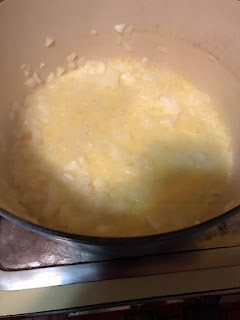It was. It would have been a better dinner. And so it goes. We learn. So, as you go through this recipe, please keep in mind that this is substantial. You can make it MORE substantial if you're REALLY hungry, but you better be really hungry.
We start with one of the early fall squashes, delicata:
The one pictured is very young. As they mature, these will turn yellow, and orange. They will do so on your counter top, but keep an eye on them. In Annalena's experience, these, and spaghetti squash, do not keep as well as the butternut and acorn varieties, so try to use them sooner rather than later.
After you've put your oven at 425, you'll cut this critter in half, lengthwise (careful. The skin is not all that tender:
Some people like to roast these seeds, but Annalena ain't got time for that. Whether you roast them or not, you have to scoop these out, with a big spoon. Then, you'll have a semi hollow squash. You can turn it upside down, and then cut each half, into semi circles:
While you're prepping the squash, and the oven is heating up, throw about a cup of pecan halves onto a baking sheet, and put them in the oven. In the time it takes for the oven to get to 425, they will roast (Annalena forgot to take pictures of this).
You now take these half moons of squash, and mix them with honey, and chili powder:
(Lest Annalena forget, the man who sells her honey, is a HUNK. Let's go visit him sometime, ok?). So, while you "reminisce" about Andrew, your honey man, put the squash, a big tablespoon of honey, two tablespoons of olive oil, and a pinch of chili powder in a bowl, together with a scanty teaspoon of salt. Toss it all together, and then dump it onto a baking sheet, covered with parchment, and smooth out the squash to a single layer. Put this into the oven, and let it roast for about 30 minutes. Turn the pieces over with some tongs, every ten minutes or so. You'll get:
If you recall, we've already roasted our pecans, they're out of the oven, and now, we've roasted our squash. You can see how much it has shrunk. So, you can combine your pecans and squash on one baking sheet, at different corners if you like. You should not mix them at this point, because the residual moisture in the squash, will undermine your toasted pecans. You COULD also combine the pecans and squash, and eat them without the salad, or you could eat the squash as is, and forget about the pecans. Remember, ragazzi, you always have options.
Let us now address the salad greens. We are using radicchio:
If you are not familiar with this beautiful, reddish purple vegetable, you would be forgiven for thinking that it must be sweet. IT IS NOT. Indeed, Annalena remembers when she first encountered radicchio in the 80s, bit into what she thought was going to be the sweetest lettuce she has ever tasted, and spat it out. Radicchio is a cicory, and all of the cicories (endive, tardivo, etc), are bitter. They are Italian, in fact, from around the Venice area, and they are very well favored by Italians. Americans, well.... we'll get there. And for what it's worth, they are very resilient, and you can quarter them, and grill or roast them, and they DO sweeten.
NOT TODAY SATAN. We're going to simply quarter these, and then slice them into thin slices:
Eyeball how much radicchio you have, and add about an equal quantity of - another bitter green - arugula:
For those of you who are concerned with "eating bitterness" (ask a Chinese friend. Many of Annalenas readers have been doing so for 2 years plus), rest assured the pecans, the squash, and our dressing, which follows, will sweeten this.
Now, to the dressing. Originally, this dressing was made, with buttermilk. Annalena had no buttermilk, but she had.... creme fraiche. And if you wish to go completely vegan (did you notice we are vegan so far?), get your hands on a thick nut milk, or make it yourself (it is not hard), and combine about half a cup of your buttermilk/creme fraiche/nut milk, together with the juice of one lemon, and another scant teaspoon of salt.
Annalena added a grated clove of garlic, and wishes she didn't. The garlic taste was very, very strong. So leave it out if you don't want that strong a flavor. Finally, add 1/4 cup of good quality olive oil, and mix the whole thing together:
And we're ready to literally toss this thing together. Put the squash and pecans into a bowl with the greens, mix them together, add the dressing, and mix it again:
This is a rather substantial salad, ragazzi. If you feel like you may be hungry, or there will be more, hungry people, you should add some fried tempeh or tofu, if you wish to keep the vegan or vegetarian aspect of it. Scallops would be nice, and so would some very rare tuna, or even some steak. As Annalena said, you have your options.
And there we are for this week. Annalena wishes you all well. Seriously, ALL of you, be well. Take care of yourselves. Share. And be nice to each other. Ultimately, all we have, is each other.






















































